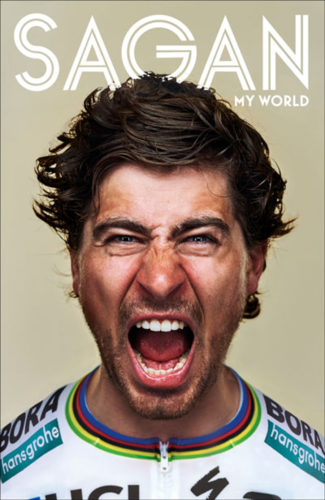By David Ward – Peter Sagan’s book, My World, is a great read for a bicycle racing fan. It is interesting because of the insight into and story of Sagan’s life, but was really enjoyable for the professional bike racing context in which it is set and on which it focuses.

I expect there will be a lot of different takes on this book. It effectively covers a lot of themes and territory in a relatively short number of pages. Well, 293 pages, but large print and wide line spacing. But my take is this: It is a great book because of the excitement it generates and Sagan’s thoughtfulness and intelligence exhibited as he relates his story of the racing his book describes.
It is divided into three parts, each one titled for one of his three consecutive world championship road race victories (Richmond, Doha, and Bergen), the only man to have accomplished that feat. It ends with an epilogue describing his victory in the 2018 Paris-Roubaix classic. Written with co-author John Deering, who of course did most of the actual writing, the book reads quickly and smoothly, and in an entertaining manner that makes it hard to put down. Or, as in my case, hit the pause button, since I actually listened to most of the book (thanks to my subscription to Audible.com) while riding my own bike, no less.
In reading this book, you get the sense at how well grounded Sagan is. Two themes running through the book bring this out. He emphasizes the idea that for each race there are “a hundred different stories”, and his is only one of them. He is often asked about planning and strategy for a race, and he is quite open about the fact that, while a plan is made, it rarely plays out that way. Rather, a race is a fluid, living thing in which you have to be alert and able to react. He is honest that winning often comes down to good luck. He is keen to point out that each rider has his own story about how each race played out.
Early in his career, Sagan adopted (from his perception of Australians) the mantra, “Why so serious?”, the second theme illustrating how grounded he is. This is referred to repeatedly throughout the book. It is a theme that has served him well. I recall how, during a year with Tinkoff he kept placing second in so many important races, and even came under criticism from his team owner, Oleg Tinkoff who threatened to negotiate his contract down. During this period, I remember Sagan making comments that reflected his fall back on this attitude. Nevertheless, he does make clear in his book how this stretch was so frustrating to him. While sitting in second place in the green points jersey standings in the Tour de France during this stretch, he says, “I was thinking of getting a new jersey made. Most second places. The brown jersey, maybe.”
And speaking of Oleg Tinkoff, it was fascinating to read Sagan’s account of riding on Oleg’s team. I suspect many people are like me, with a not very favorable view of the man. But Sagan, while speaking frankly of Tinkoff, also speaks positively overall of him. What Sagan seemed to appreciate most about Tinkoff was his frankness. If he was happy with you, he told you. If he was upset with you, he told you, and then he was over it. “You were shit today, Peter. But you tried, so f___ it, let’s go eat. Do you fancy caviar” He summarizes Tinkoff with these words, “As you can imagine, his capacity to offend is limitless, but he is also fantastic, engaging, and provocative company.”
Sagan makes clear that he recognizes bike racing as entertainment. Those who have followed him since he burst onto the pro racing scene, which is most of us pro cycling fans, know what an entertainer he is. He describes throughout the book his efforts to embrace this role.
Sagan also spends time describing a number of his adversaries, quickly making clear that he mostly knows them as cyclists. He discusses their styles and strengths, particularly the sprinters whom of course he knows best because they are the ones he mostly competes against. But it is impressive is that he never speaks ill of anyone. He praises and complements certain riders, and is muted and restrained on the things he might be inclined to criticize. He would clearly have liked Mark Cavendish to come to his defense following Cavendish’s spectacular crash during the finish line sprint into Vittel during the 2017 Tour de France for which Sagan was blamed and criticized, and then tossed from the Tour. In the end, it was a bad decision, and most of us came to recognize that. On Cavendish’s failure to speak up, Sagan says, “I was really hoping that Mark might go on Twitter to tell the world that it was a bit of joke, but that was his decision to make. Not mine, and I respect that. It would also have obviously been in opposition to his team’s position, which is never a good place to be.”
Finally, one race that epitomizes Sagan for me was stage 11 of the 2016 Tour de France from Carcasonne to Montpelier. Battered by crosswinds toward the end of the stage and the peloton forming into echelons, Sagan made certain to stay at the front. With 11 kilometers to go and feeling good, he pushed the pace and, joined by his teammate, Maciej Bodnar, opened a small gap.
Another alert leader also staying close to the front, Chris Froome, saw the gap form and Sagan at the lead. He bridged, as then did Geraint Thomas. “I thought at first he was trying to close me down, which would be fair enough. But a quick look and a word between us established that we had seen the same opportunity: ‘Let’s do it’”. As Sagan explains, [W]e slipped into team trial mode immediately. . . . We smashed it for 10 kilometers . . . [W]hen that break is comprised of the race leader, the points leader, and two of the strongest teammates . . . good luck.” Sagan won and Froome took second and gained precious bonus seconds.
This win illustrates intelligent racing, good preparation and talent which allowed Sagan and Froome to be in key places at a critical time, and luck in their favor with crosswinds battering and splitting any possible chase. I remember watching this stage and how exciting it was. This is Sagan, and pro racing, at its finest.
I really enjoyed this book, as will any fan of professional road racing. It provided a small view into Sagan’s personal life, a detailed view into his professional racing life, an understanding of his personal and inner character, and exciting tales of professional bike racing.
My World by Peter Sagan, Hardcover with two 8-page color photo sections., 6″ x 9″, 320 pp., $24.95, ISBN: 9781937715946, Velopress, Boulder, Colorado, 2018










